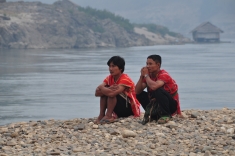
Karen ethnic Thai villagers at the Salween River will be affected by the planned Hat Gyi Dam in Burma’s Karen state.
The strong turn-out for Myanmar’s elections on Sunday demonstrates that people in Myanmar are not only eager to participate, but are also demanding their right to participate in decisions which will impact their lives and the future of their country. While communities along the Salween River have long voiced their opposition to the hydropower dams planned on their river, the implications of the changes happening in Myanmar only further calls into question Thailand’s future power development plans.
In Thailand’s new Power Development Plan (PDP 2015), which was approved in May 2015, the Thai electricity industry – led by the Electricity Generating Authority of Thailand (EGAT) – is increasingly looking to its neighbors in Myanmar and Laos to produce electricity for import into Thailand. In addition to the controversial Xayaburi Dam and other hydropower dams in Laos, EGAT has also taken steps to develop the Hat Gyi and the Mong Ton dams on the Salween River in Myanmar’s Karen and Shan states. Both projects, along with other dams proposed on the Salween River, are within active armed conflict zones not far from Thailand’s western border.
Communities who would be impacted by these hydropower projects – many of whom are already refugees, having been uprooted from their homeland during the forced relocation policy by the Burmese military in the late 90s – have been vocal in their opposition to the Hat Gyi and Mong Ton dams.
In September, more than a dozen villagers representing communities affected by power projects throughout Thailand and in neighboring countries, gathered in Bangkok to express their concerns about Thailand’s new Power Development Plan. At this meeting, a Thai-Karen ethnic leader Pongpipat Meebenjamat raised concern over the Salween dams’ impacts on Myanmar’s war-torn regions: “What seems like ‘cheap’ electricity from the dams, will come at a high cost for thousands of refugees,” said the leader. “The future reservoir areas are homes of those who have fled the war to Thailand. They are still waiting to return once peace is restored.”
“Do we really need electricity from these kinds of dams?” he continued to ask.
This question was brought up throughout the day’s meeting, by communities along the Salween and Mekong rivers, who are threatened by hydropower projects, as well as communities in southern Thailand who are fighting to stop the development of coal-fired power plants in Krabi and Thepa districts.
Under the PDP 2015, there will be numerous new power plants built by 2036, with an installed capacity of up to 57,459 megawatts. But why does Thailand’s energy industry continue to propose new power plants at home and abroad, when the country has existing infrastructure to produce what is needed? Furthermore, who will benefit from these projects, and at what cost?
While Thailand’s energy industry looks abroad in its desire to increase power and profit, it ignores feasible and less costly solutions at home. Analysis presented by experts suggests that Thailand has a larger electricity supply than it actually needs and that energy efficiency measures, along with renewing contracts of existing projects and/or retrofitting the existing power plants, will help reduce the need for imported electricity.
In order for communities who would be impacted by Thailand’s power development plan to have a say in decisions affecting their future, villagers presented a petition following September’s meeting to the Thailand’s Ministry of Energy calling for the cancellation of the PDP 2015 and for a new plan to be developed through a transparent and participatory process.
Just as the election in Myanmar has the potential to significantly change the political landscape and the future of planned dams on the Salween River, it may be one more reason for Thailand to reconsider its Power Development Plans.
Source: http://www.internationalrivers.org/blogs/259-6
